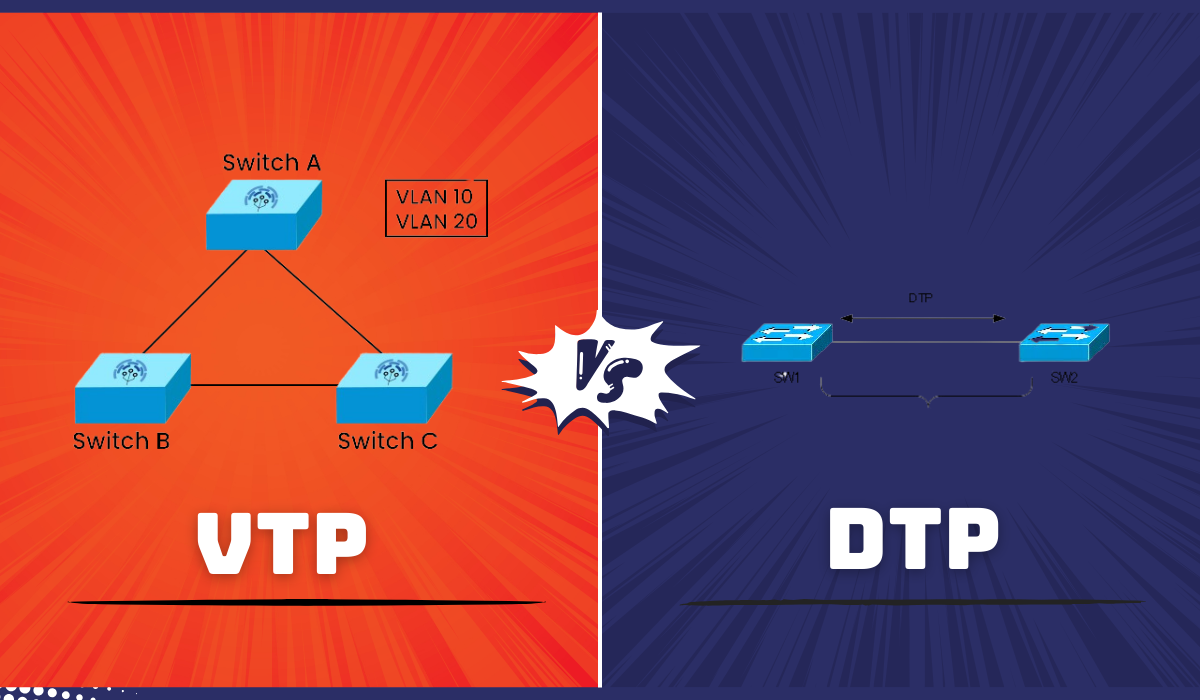
Introduction
Efficient network management requires a deep understanding of networking protocols. In this article, we will explore and dissect the distinctions between VTP and DTP, both of which are integral to network configuration. These protocols serve unique functions, come with their own set of features, and are indispensable in creating robust and secure networks. By the end of this comprehensive guide, you’ll be well-versed in the roles, advantages, and ideal scenarios for deploying VTP and DTP.
VTP vs DTP: Unraveling the Differences
Let’s embark on a detailed exploration of VTP and DTP to understand how each protocol functions and where it excels.
VTP (VLAN Trunking Protocol)
VTP, which stands for VLAN Trunking Protocol, is primarily responsible for managing VLAN configurations within a network. Here are the key attributes that distinguish VTP:
- Centralized Control
VTP provides centralized control of VLAN configurations across the network. It acts as a single point of administration, streamlining VLAN management.
- VLAN Propagation
A core function of VTP is to propagate VLAN information throughout the network. This ensures consistency in VLAN configurations and reduces the risk of manual configuration errors.
- Configuration Modes
VTP operates in three modes: server, client, and transparent. Each mode serves a specific role in managing VLANs, making VTP highly versatile in various network setups.
- Risks of Misconfiguration
While VTP is a valuable tool for VLAN management, it carries a potential risk of misconfiguration. Unauthorized or inadvertent changes can impact the entire network, emphasizing the importance of careful management.
DTP (Dynamic Trunking Protocol)
DTP protocol, or Dynamic Trunking Protocol, focuses on the establishment and negotiation of trunk links between network devices. Let’s delve into the distinctive features of DTP:
- Automatic Trunking
DTP automates the process of trunk link establishment, making it an efficient choice for connecting switches. It simplifies the setup of high-speed connections between switches.
- Negotiation Modes
DTP offers different negotiation modes: dynamic auto, dynamic desirable, and nonegotiate, each tailored to specific requirements in trunk link establishment.
- Trunk Security
While DTP streamlines automated trunking, it’s crucial to configure the appropriate mode to ensure security. Leaving trunk links open can expose the network to potential vulnerabilities.
- Compatibility Considerations
Understanding the various DTP negotiation modes is essential for ensuring compatibility between network devices. Mismatched modes can lead to connectivity issues.
Pros and Cons of VTP and DTP
VTP Advantages
- Centralized management
- Reduced configuration errors
- Efficient VLAN propagation
VTP Disadvantages
- Risk of misconfiguration
- Prone to errors if not carefully managed
DTP Advantages
- Automated trunk link establishment
- Streamlined connectivity between switches
DTP Disadvantages
- Security concerns if not configured properly
- Compatibility issues when negotiation modes don’t align
When to Use VTP and DTP?
The choice between VTP and DTP depends on your network’s specific requirements. Here are some scenarios that highlight when each protocol is most suitable:
- When to Use VTP
Centralized VLAN Control: VTP is the ideal choice when you require centralized control over VLAN configurations.
Consistency Across the Network: Use VTP to ensure uniform VLAN information across your network, reducing configuration disparities.
- When to Use DTP
Automated Trunk Linking: Opt for DTP when you need automated trunk link establishment, particularly in setups with multiple switches.
Efficient Connectivity: DTP is invaluable for efficient and seamless connectivity between switches, simplifying network management.
Extended Topics
- VLANs and Their Significance
VLANs (Virtual Local Area Networks) are pivotal components of network management. They segment a physical network into multiple logical networks, enhancing security and network efficiency. Discover the world of VLANs and how VTP and DTP play a critical role in their configuration.
- The Role of Trunk Links
Understanding trunk links is fundamental in the context of DTP. Learn how these high-speed connections enable the transmission of multiple VLANs over a single link between network devices.
- Security Implications and Best Practices
Network security is of paramount importance. Explore the security implications of VTP and DTP, and discover best practices to protect your network from unauthorized access and vulnerabilities.
Future of Network Protocols
Stay ahead of the curve by delving into emerging network protocols and technologies. Learn how VTP and DTP fit into the evolving landscape of network management, and gain insights into the alternatives and innovations on the horizon.
Case Studies: Real-World Applications
Real-world examples can provide valuable insights. Explore case studies where organizations have successfully implemented VTP and DTP to optimize their network configurations and enhance network performance.
Frequently Asked Questions
Are VTP and DTP compatible with each other?
No, VTP and DTP serve different purposes and are not designed to work together.
Can I use VTP and DTP simultaneously on the same network?
Yes, you can use both protocols in the same network, provided you understand their respective roles and configure them correctly.
What security measures should I consider when using DTP?
To enhance security, configure DTP in the “nonegotiate” mode to prevent unauthorized trunk link negotiation.
How do I prevent VTP misconfigurations?
Implement proper access controls and regularly monitor VTP configurations to avoid unauthorized changes.
What is the default mode for VTP and DTP?
The default mode for VTP is “server,” while the default mode for DTP is “dynamic auto.”
Can I change the DTP negotiation mode after it’s been configured?
Yes, you can change the DTP negotiation mode on an interface, but it’s essential to do so carefully to avoid network disruptions.
Conclusion
In the realm of networking, a firm grasp of protocols like VTP and DTP is essential for efficient network management. VTP simplifies VLAN configuration management, while DTP automates trunk link establishment. Your choice between the two depends on your network’s unique requirements and security considerations. With this comprehensive guide, you’re now well-prepared to make informed decisions on when and how to use VTP and DTP to optimize your network configurations.


